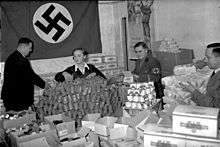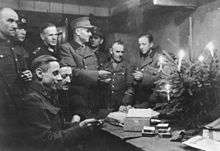Christmas in Nazi Germany

In Nazi Germany, attempts were made to bring the celebration of Christmas in line with Nazi ideology. The Jewish origins of Jesus and the commemoration of his birth as the Jewish Messiah was troubling for Nazi racial beliefs. Between 1933 and 1945, government officials attempted to remove these aspects of Christmas from civil celebrations and concentrate on the pre-Christian aspects of the festival. Hymns and decorations were secularised. However church and private celebrations remained Christian in nature.
Background
Christianity had long been the main faith of the Germanic peoples, dating to the missionary work of Columbanus and St. Boniface in the 6th–8th centuries.[1] The Nazis ruled Germany from 1933-1945. Nazism wanted to transform the subjective consciousness of the German people—their attitudes, values and mentalities—into a single-minded, obedient "national community".[2] According to Shirer, "under the leadership of Rosenberg, Bormann and Himmler—backed by Hitler—the Nazi regime intended to destroy Christianity in Germany, if it could, and substitute the old paganism of the early tribal Germanic gods and the new paganism of the Nazi extremists."[3]
Early Nazi celebrations of Christmas occurred in 1921 when Adolf Hitler made a speech in a beer hall in Munich to 4,000 supporters. Undercover police reporters wrote that the crowd cheers when Hitler condemned, "the cowardly Jews for breaking the world-liberator on the cross", swearing, "not to rest until the Jews… lay shattered on the ground." The crowd then sang carols and nationalist hymns around a Christmas tree, with gift being donated to working-class attendees of the speech.[4] After taking power in 1933, Nazi ideologues initially sought to reject Germany's long held Christmas traditions - renaming the festival Julfest, and propagating its Germanic origins as the celebration of the winter solstice. But for the majority of Germans, the Christian traditions remained the basis of the holiday, and the churches were outraged by the removal of Christ from Christmas and maintained the Christian traditions within themselves.[5]
Christmas under the Nazi Dictatorship
Nazi ideologists claimed that the Christian elements of the holiday had been superimposed upon ancient Germanic traditions.[6] They argued that Christmas Eve originally had nothing to do with the birth of Jesus Christ, but instead celebrated the winter solstice and the 'rebirth of the sun',[6] that the swastika was an ancient symbol of the sun, and that Santa Claus was a Christian reinvention of the Germanic god Odin. Accordingly, holiday posters were made to depict Odin as the "Christmas or Solstice man", riding a white charger, sporting a thick grey beard and wearing a slouch hat, carrying a sack full of gifts. Other changes were made to the manger, which was replaced by a Christmas garden containing wooden toy deer and rabbits; Mary and Jesus were also depicted as a blonde mother and child.[6]
The Christmas tree was also changed. The traditional names of the tree, Christbaum or Weihnachtsbaum, was renamed in the press as fir tree, light tree or Jul tree. The star on the top of the tree was sometimes replaced with a swastika, a Germanic "sun wheel" or a Sig rune, and swastika-shaped tree lights.[6][7][8] During the height of the movement, an attempt was made to remove the association of the coming of Jesus and replace it with the coming of Hitler, referred to as the "Saviour Führer".[6]
Christmas carols were also changed. The words to "Silent Night" were changed so it made no reference to God, Christ and religion.[6] Words were also changed to the hymn "Unto Us a Time Has Come" so as to remove references to Jesus. The modified version of the hymn was in use for several more years in post-war Germany.[7][9] The most popular carol promoted by the Nazis was Hans Baumann's "Exalted Night of the Clear Stars" [Hohe Nacht der klaren Sterne], which replaced traditional Christian themes with Nazi racial ideologies. The carol was popular after the collapse of Nazi Germany, was regularly performed into the 1950s, and is still sometimes performed in the modern day.[4]
Shop catalogues containing children's toys made available during the holiday season featured chocolate SS soldiers,[8] toy tanks, fighter planes and machine guns. As a sign of appreciation, Heinrich Himmler frequently gave SS members a Julleuchter ("Yule lantern"), a kind of ornate Germanic candlestick, some of which were made at Dachau concentration camp.[6][10] Housewives were prompted to bake biscuits in the shape of birds, wheels and swastikas for their children.[11]

By 1944 the movement to remove Christian influences from Christmas lessened as the government concentrated more on the war effort.[6][11] In 1944 civil celebrations of Christmas marked the festival as a day of remembrance for Germany's war dead.[12]
Opposition
While most Germans embraced the Nazi's rebranding of Christmas, at time it was reported that there was hostility by a minority. Files from the National Socialist Women's League reported, "that tensions flared when propagandists pressed too hard to sideline religious observance, leading to "much doubt and discontent.'"[4] The clergy were among those opposed the redefining of Christmas. Reports say that in Düsseldorf the clergy used Christmas to promote women's clubs and encourage membership; the Catholic clergy threatened any woman who joined the National Socialist Women's League with excommunication; and some religious women boycotted Christmas events organised by National Socialist Women's League.[4]
See also
References
- ↑ Encyclopædia Britannica Online - Germany : Religion; web 23 May 2013
- ↑ Ian Kershaw; The Nazi Dictatorship: Problems and Perspectives of Interpretation; 4th Edn; Oxford University Press; New York; 2000"; pp. 173–74
- ↑ William L. Shirer; The Rise and Fall of the Third Reich; Secker & Warburg; London; 1960; p. 240
- 1 2 3 4 Perry, Joe (December 22, 2015). "How the Nazis co-opted Christmas". The Conversation. Retrieved December 25, 2015.
- ↑ Christmas: Not such a holy night under the Nazis; DW Online; by Faith Thomas; 24/12/09
- 1 2 3 4 5 6 7 8 Paterson, Tony (21 December 2009). "How the Nazis stole Christmas". London: The Independent. Retrieved 21 December 2009.
- 1 2 Boyes, Roger (17 November 2009). "How the Nazis tried to take Christ out of Christmas". The Times. Retrieved 21 December 2009.
- 1 2 Morrison, Rebecca K. (22 December 2010). "Did the Germans invent Christmas?". The Times Literary Supplement. Retrieved 23 November 2015.
- ↑ "How Hitler and the Nazis tried to steal Christmas". London: Daily Telegraph. 17 November 2009. Retrieved 21 December 2009.
- ↑ Smith, David Gordon (13 November 2009). "Swastikas and Tinsel: How the Nazis Stole Christmas". Der Spiegel. Retrieved 23 December 2009.
- 1 2 "How Hitler's Nazi propaganda machine tried to take Christ out of Christmas". London: Daily Mail. 18 November 2009. Retrieved 21 December 2009.
- ↑ Hall, Allan. "Hitler's Christmas party: Rare photographs capture leading Nazis celebrating in 1941". Daily Mail. London.
External links
- Inside a Nazi Christmas Party, 1941 - slideshow by Life magazine
